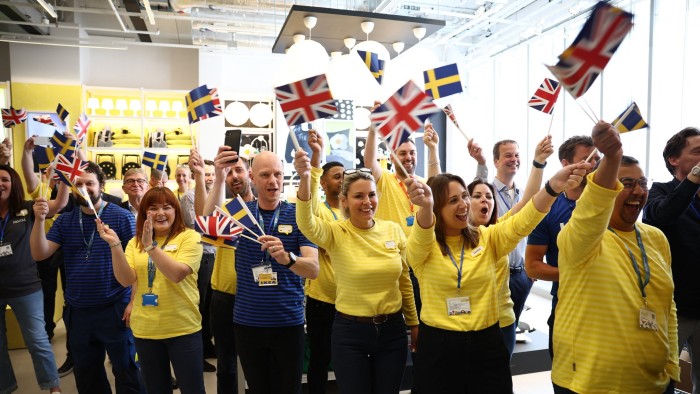Unlock the Editor’s Digest for free
Roula Khalaf, Editor of the FT, selects her favourite stories in this weekly newsletter.
The writer is the FT’s architecture and design critic
Oxford Street and its neighbourhood were once the heart of London’s furniture retail. Huge stores like Maple & Co, Waring & Gillow, Liberty and Heals were piled with sumptuous pieces in exotic settings, or later with sleek, streamlined pieces that introduced modernism to the masses. Vast windows allowed luxurious displays and room settings announced changes in metropolitan taste, a constantly shifting panorama of design and craft.
Last week, Ikea opened its new shop at Oxford Circus in what was once the Peter Robinson department store and more recently Topshop. After a long gestation, the mostly subterranean interior has reopened as a warren burrowed through cheap stuff piled high, rammed with shoppers and, on the opening day, a DJ and staff handing out free blue bags. Mayor Sadiq Khan was there too, trumpeting a revival of a street that has suffered decades of decline.
It is a curious sight; the garish blue and yellow of big-box retail arriving on London’s once-premier shopping street. It may be good for footfall but somehow it doesn’t seem a step-up. Windows are blacked out with big, ugly ads. This is a shopfront that gives nothing back to the public realm. Once inside you’re in the familiar windowless labyrinth that winds on, like duty free when you want to get to the gate, seemingly for ever.
If the old Oxford Street department stores attempted to seduce through luxury, the new Ikea intends to impress with sheer quantity and low prices. Aspiration is replaced by realism. Despite room settings based on the teeny dimensions of young Londoners’ actual (rather than ideal) living spaces, the suggestion is that you, too, could live the Scandi dream, surrounded by affordable cushions, resplendent in cheerful modernist hygge.
Yet as I watched mostly young customers loading up their bags with 75p plates and cutlery sets cheaper than a bag of crisps, I couldn’t help wondering whether this really is the future.
Ikea’s early success in the UK was based on a generation desperate to escape the aesthetic of their parents’ homes — the three-piece suites, porcelain knick-knacks and the flickering red glow of the fake electric fire. They wanted to live like modern grown-ups in modern homes, with chic shelving and cool coffee tables, Venetian blinds rather than swags, to live like people did in lofts. The retailer’s trick was to create coherent room settings that enabled customers to see themselves in contemporary surroundings entirely kitted out with matching ranges; well lit, colour co-ordinated and fun.
The reality of course, was different. Everything looked worse in the exigencies of actual, lived domestic space. And then there was the self-assembly. The transference of production to the customer, the hours of unpaid labour allowing Ikea to make bigger profits through ease of transport, caused frustration and resentment.
Will today’s young people be as seduced as earlier generations were? For many, the lifestyles and generous spaces of their parents are not a memory of stifling conservatism but an impossible dream. The trends seem not to be to chuck out the chintz but to bring it back in, creating the cluttered cottagecore vision of cosy domesticity. Or the mid-century clean, modern interiors from a period of optimism when design could solve problems — teak sideboards and Danish chairs. Even the long-derided brown furniture, the chests of drawers and dining tables, are again appreciated as sustainable objects, incredible quality compared with fibreboard flat packs.
Ikea’s retail aesthetic transplanted to the West End appears a little obscene, like too much cheap tat. It is a reminder of overproduction and, no matter how egalitarian, modern and environmentally conscious its philosophy might be, it looks like fast fashion for interiors, an architecture of overconsumption.


